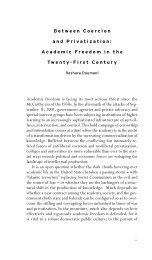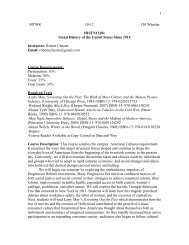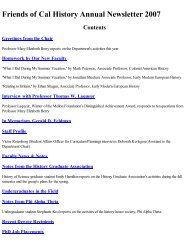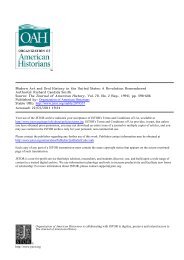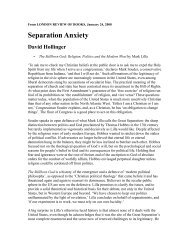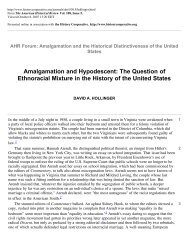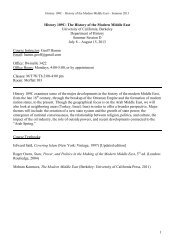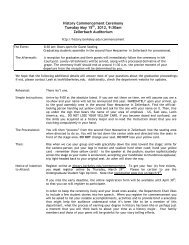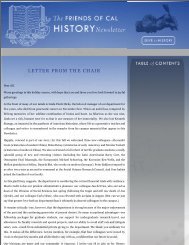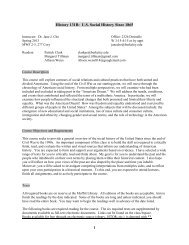My Grandmother and Other Stories: Histories of the Palestinians as ...
My Grandmother and Other Stories: Histories of the Palestinians as ...
My Grandmother and Other Stories: Histories of the Palestinians as ...
You also want an ePaper? Increase the reach of your titles
YUMPU automatically turns print PDFs into web optimized ePapers that Google loves.
my gr<strong>and</strong>fa<strong>the</strong>r’s second marriage many times from<br />
my early childhood, both from my fa<strong>the</strong>r, <strong>and</strong> my<br />
aunts.<br />
10<br />
The villagers relayed a number <strong>of</strong> stories about<br />
<strong>the</strong> generosity <strong>of</strong> Abu Fayyad, saying that his name<br />
(which means “outpouring”) w<strong>as</strong> appropriate because<br />
he w<strong>as</strong> also “<strong>the</strong> fa<strong>the</strong>r <strong>of</strong> <strong>the</strong> poor”. These qualities<br />
appeared to be well-known to my gr<strong>and</strong>mo<strong>the</strong>r’s<br />
family.<br />
11<br />
The child mortality rate w<strong>as</strong> very high at <strong>the</strong><br />
end <strong>of</strong> Ottoman rule <strong>and</strong> during <strong>the</strong> British M<strong>and</strong>ate<br />
period. Abu Fayyad had married twice before my<br />
gr<strong>and</strong>mo<strong>the</strong>r. Jalilah bore him three children–Fayyad<br />
lived, while two girls died in childhood. His second<br />
wife did not have any children <strong>and</strong>, according to <strong>the</strong><br />
oral stories, died at an early age four or five years<br />
before Abu Fayyad married Zahra.<br />
12<br />
Abu Jamil began recording deaths in <strong>the</strong> village<br />
only from <strong>the</strong> end <strong>of</strong> <strong>the</strong> 1920s, so I w<strong>as</strong> not able<br />
to learn <strong>the</strong> exact date <strong>of</strong> my gr<strong>and</strong>fa<strong>the</strong>r’s death.<br />
His first wife, Jalilah, died (according to <strong>the</strong> record<br />
book) on 30 November, 1931. Abu Jamil wrote,<br />
“The death <strong>of</strong> Jalilah, <strong>the</strong> wife <strong>of</strong> <strong>the</strong> late Salim Hajj<br />
Krayyim.”<br />
13<br />
The remnants <strong>of</strong> this patriarchal culture are alive<br />
in many rural are<strong>as</strong> in Palestine <strong>and</strong> in o<strong>the</strong>r Arab<br />
countries.<br />
14<br />
Refer, for example, to Shukri Arraf’s book, The<br />
Palestinian Arab Village (Third edition, Maaliyah,<br />
1996).<br />
15<br />
Abu Jamil documented this event in his record<br />
book accurately <strong>and</strong> briefly on page 4, number 82,<br />
writing, “Hussein Khalil Qaddah w<strong>as</strong> caught in Salim<br />
Hajj’s house by <strong>the</strong> camp police Abed Othman <strong>and</strong><br />
Yousef al-Rayyes al-Ghazzawi on 13/9/1929”.<br />
16<br />
Ibid., p.5, number 94. The sentence w<strong>as</strong> issued<br />
against Hussein Khalil after a suit filed by al-<br />
Ja’uniyya on 14 November, 1929–that is, two months<br />
after his arrest.<br />
17<br />
Ibid., page 7, number 153. Ahmad al-Amin, in<br />
collaboration with Tawfiq Jabir, Mohammad Bisher<br />
<strong>and</strong> o<strong>the</strong>rs, were charged with <strong>the</strong> murder. The<br />
defendants were acquitted, however, <strong>and</strong> it soon<br />
became clear that o<strong>the</strong>rs were responsible for Khalil’s<br />
murder.<br />
18<br />
Ibid. Abu Jamil c<strong>as</strong>ually recorded <strong>the</strong> names<br />
<strong>of</strong> those who were later alleged <strong>as</strong> <strong>the</strong> killers <strong>of</strong><br />
Khalil Qaddah in <strong>the</strong> margins next to <strong>the</strong> record<br />
<strong>of</strong> his murder <strong>and</strong> burial. Those rumored to have<br />
participated in <strong>the</strong> killing included Ahmad Fayyad,<br />
<strong>the</strong> son <strong>of</strong> Fayyad, born to Salim Hajj Krayyim. In<br />
any c<strong>as</strong>e factionalism in Palestinian society is an<br />
important subject that Arab scholars rarely venture<br />
into, <strong>and</strong> which exceeds <strong>the</strong> boundaries <strong>of</strong> this<br />
modest paper. For more on this see. ‘Isa Khalaf,<br />
Politics in Palestine: Arab Factionalism <strong>and</strong> Social<br />
Disintegration, 1939-1948 (Albany: Sunny, 1991). In<br />
my own childhood, I remember some fights (toshe,<br />
plural tuw<strong>as</strong>h) that broke out involving my relatives<br />
during <strong>the</strong> 1950s <strong>and</strong> ‘60s <strong>and</strong> even several years<br />
after. Israeli military authorities exploited <strong>the</strong>se minor<br />
feuds <strong>as</strong> part <strong>of</strong> <strong>the</strong>ir ‘divide <strong>and</strong> conquer’ policy,<br />
putting heads <strong>of</strong> households in competition with each<br />
o<strong>the</strong>r over <strong>the</strong>ir relationships with police <strong>and</strong> Israeli<br />
institutions.<br />
19<br />
Shaykh Nabhan w<strong>as</strong> a Sufi shaykh who people<br />
believed had <strong>the</strong> ability to cure <strong>the</strong> sick <strong>and</strong> do<br />
o<strong>the</strong>r miracles. Abu Jamil w<strong>as</strong> his accountant or<br />
book keeper at <strong>the</strong> time. His son, Shaykh Mahmoud<br />
Nabhan, inherited his status after his death. I have<br />
some recollection <strong>of</strong> arguing with my mo<strong>the</strong>r about<br />
Shaykh Mahmoud’s inherited abilities to cure <strong>the</strong><br />
sick <strong>and</strong> help <strong>the</strong> needy.<br />
20<br />
The elderly recount stories that confirm <strong>the</strong><br />
construction during <strong>the</strong> days <strong>of</strong> Dhahir al-’Umar<br />
al-Zaydani <strong>of</strong> <strong>the</strong> village mosque <strong>and</strong> a number <strong>of</strong><br />
homes around it, including <strong>the</strong> house I w<strong>as</strong> raised in.<br />
I later found evidence <strong>of</strong> <strong>the</strong> good relations between<br />
Dhahir al-’Umar <strong>and</strong> his children <strong>and</strong> <strong>the</strong> people <strong>of</strong><br />
Majd al-Kroum. When Ahmad P<strong>as</strong>ha al-Jazzar (‘<strong>the</strong><br />
butcher’), <strong>the</strong> ruler <strong>of</strong> Acre for about three decades<br />
(1775-1804), pursued <strong>the</strong> Ziyadina in <strong>the</strong> Galilee<br />
villages, <strong>the</strong> people <strong>of</strong> Majd al-Kroum took <strong>the</strong> side<br />
<strong>of</strong> ‘Ali, <strong>the</strong> son <strong>of</strong> Dhahir. Al-Jazzar took revenge <strong>and</strong><br />
killed many <strong>of</strong> <strong>the</strong>m, sending <strong>the</strong>ir decapitated heads<br />
to Istanbul <strong>as</strong> pro<strong>of</strong> <strong>of</strong> his victory in <strong>the</strong> battle on<br />
[ 74 ] HISTORICAL FEATURES From Seferberlik to <strong>the</strong> Nakba



